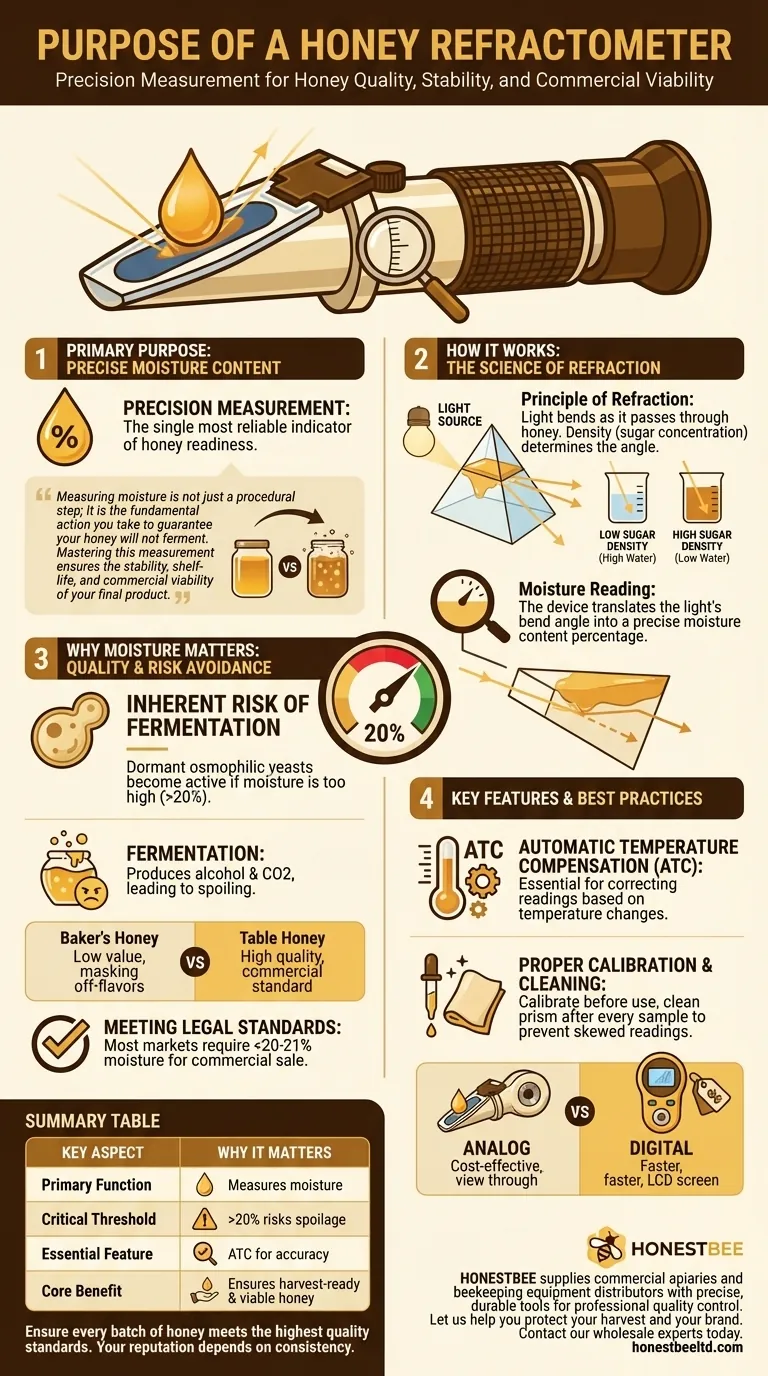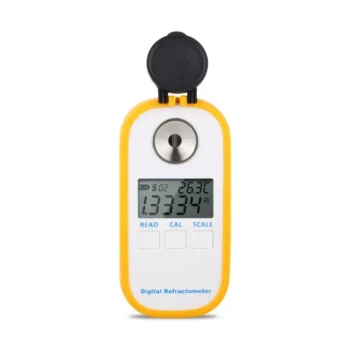The primary purpose of a honey refractometer is to precisely measure the moisture content of honey. This single measurement is the most reliable indicator of whether your honey is ready for harvest, ensuring it will remain stable and resist spoilage over time. It is an essential tool for quality control for both hobbyist and commercial beekeepers.
Measuring moisture is not just a procedural step; it is the fundamental action you take to guarantee your honey will not ferment. Mastering this measurement ensures the stability, shelf-life, and commercial viability of your final product.

How a Refractometer Works: The Science of Light and Sugar
A honey refractometer operates on a simple, reliable principle of physics. Understanding this mechanism helps you trust the readings it provides.
The Principle of Refraction
Refraction is the bending of light as it passes from one medium to another, such as from air into a liquid. The density of the liquid determines how much the light bends.
Honey is a supersaturated solution of sugars in water. The higher the concentration of sugar, the denser the honey becomes.
From Light Bending to a Moisture Reading
A refractometer shines a light through a thin sample of your honey placed on a prism. The device measures the angle at which the light bends.
Because the sugar-to-water ratio directly correlates to the honey's density, the instrument can translate the angle of refraction into a precise moisture content percentage. It displays this reading on a built-in scale.
Why Moisture Content is the Critical Factor in Honey Quality
A refractometer does more than provide a number; it protects your honey from degradation, ensures it is legally compliant, and safeguards your reputation.
The Inherent Risk of Fermentation
All raw honey contains dormant, naturally occurring osmophilic yeasts. These yeasts remain inactive as long as the water content is low enough.
If the moisture level is too high—generally considered to be above 20%—these yeasts can become active. They begin to consume the sugars, producing alcohol and carbon dioxide in a process called fermentation.
Avoiding "Baker's Honey"
Fermented honey has a distinct sour or "off" taste and aroma, often with visible bubbling. It is no longer suitable for sale as table honey.
This spoiled product is often downgraded to "baker's honey," a low-value commodity used in commercial baking where the off-flavors can be masked. Using a refractometer is the key to preventing this outcome.
Meeting Legal and Commercial Standards
For honey to be sold commercially in most markets, it must meet established quality standards. A common legal maximum for moisture content is around 20-21%.
Consistently producing honey below this threshold is non-negotiable for any commercial operation. It demonstrates professionalism and guarantees a high-quality product for the consumer.
Understanding the Key Features and Pitfalls
While easy to use, the accuracy of a refractometer depends on certain features and proper handling. Ignoring these can lead to flawed readings.
The Necessity of Automatic Temperature Compensation (ATC)
Honey's density changes with temperature. A warm sample will appear to have a higher moisture content than the same sample when it's cold, which can lead to inaccurate readings.
Refractometers with Automatic Temperature Compensation (ATC) have a built-in bimetallic strip that automatically corrects the reading for the ambient temperature. For serious beekeeping, ATC is not an optional feature; it is essential for accuracy.
The Need for Proper Calibration and Cleaning
Your instrument is only as reliable as your procedure. Always calibrate the refractometer before the first use of the day, typically with distilled water or a specialized calibration oil.
After each measurement, you must thoroughly clean the prism with a soft, damp cloth. Any leftover honey residue will skew the reading of the next sample.
Analog vs. Digital Displays
Analog refractometers require you to hold the device up to a light source and read the measurement on an internal scale. They are cost-effective and reliable.
Digital refractometers display the reading on an LCD screen, which eliminates any ambiguity in interpreting the scale. They are generally faster and easier to use but come at a higher price point.
Making the Right Choice for Your Goal
The ultimate purpose of the refractometer is to give you control. How you apply that control depends on your specific objective.
- If your primary focus is hobbyist production: Use the refractometer to confidently decide when to harvest, ensuring your hard-earned honey remains delicious and shelf-stable for personal use.
- If your primary focus is commercial sales: Rely on the refractometer to guarantee every batch meets legal moisture standards, protecting your brand's reputation for consistent, high-quality honey.
By mastering this simple tool, you move from hoping your honey is ready to knowing it is perfect.
Summary Table:
| Key Aspect | Why It Matters |
|---|---|
| Primary Function | Measures honey moisture content with precision. |
| Critical Threshold | Moisture above ~20% risks fermentation and spoilage. |
| Essential Feature | Automatic Temperature Compensation (ATC) for accuracy. |
| Core Benefit | Ensures honey is harvest-ready and commercially viable. |
Ensure every batch of honey meets the highest quality standards.
As a beekeeper, your reputation depends on the consistency and stability of your product. A reliable honey refractometer is your first line of defense against fermentation and spoilage.
HONESTBEE supplies commercial apiaries and beekeeping equipment distributors with the precise, durable tools needed for professional quality control. Let us help you protect your harvest and your brand.
Contact our wholesale experts today to discuss the right refractometer for your operation.
Visual Guide

Related Products
- Precision Honey Refractometer Instrument for Quality Assessment
- Digital Honey Refractometer for Precision Measurement of Optimal Honey Quality
- HONESTBEE 72 Frame Industrial Electric Honey Extractor for Beekeeping
- 8-Frame Electric Self-Reversing Honey Extractor Spinner for Commercial Honey Extraction Equipment
- HONESTBEE 3-Frame Manual Acrylic Honey Extractor
People Also Ask
- What are the key points for proper usage of a honey refractometer? Ensure Accurate Moisture Readings Every Time
- Why is a honey refractometer considered essential for commercial beekeepers? Ensure Honey Quality and Profitability
- What are the key steps to using a honey refractometer? Ensure Honey Quality & Prevent Fermentation
- What is a honey refractometer and what is its purpose? Ensure Honey Quality and Prevent Spoilage
- What are the benefits of using a Pocket Digital Honey Refractometer? Achieve Precision & Speed in Honey Quality Control



















